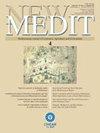Oasis extension trajectories in Kebili territory, southern Tunisia: drivers of development and actors’ discourse
IF 1.2
4区 经济学
Q3 AGRICULTURAL ECONOMICS & POLICY
引用次数: 0
Abstract
Since the 1970s, the Kebili region southern Tunisia has undergone significant territorial changes due to the expansion of date palm plantations based on illicit boreholes tapping the underlying deep aquifers. These private initiatives, called “extensions”, have developed on collective unfarmed areas, outside historical oases and have raised sustainability concerns. To address the groundwater sustainability, local actors need to build a joint vision of on-going dynamics. The objective of this study is: (i) to analyse the trajectories of the oasis extensions, (ii) to give an overview of the socio-economic and the environmental drivers and (iii) to assess how local actors assess these extensions. The study builds on spatial analysis, on surveys and participatory workshops with actors of the region. The development of extensions was triggered by economic factors and based on innovative ways of accessing water, land, and energy. Extensions, that were first created on lands in proximity of ancient oases then spread further-out to other areas, can be described as spontaneous. Other were developed on lands located far from ancient oases, with the support of local councils in charge of land management. Actors have identified the overexploitation of groundwater as the main threat to the sustainability of the region, but no discussion has been initiated yet on how to deal with this threat. Results derived from this study could support discussions about the future of these areas.突尼斯南部凯比利地区绿洲扩张轨迹:发展驱动因素和行动者话语
自20世纪70年代以来,突尼斯南部的凯比利地区发生了重大的领土变化,原因是基于非法钻孔开采深层含水层扩大了椰枣种植园。这些被称为“扩展”的私人举措是在历史绿洲之外的集体未设防地区发展起来的,并引发了对可持续性的担忧。为了解决地下水的可持续性问题,当地行动者需要建立一个持续动态的共同愿景。本研究的目的是:(i)分析绿洲扩展的轨迹,(ii)概述社会经济和环境驱动因素,(iii)评估当地行为者如何评估这些扩展。这项研究建立在空间分析、调查和与该区域行动者举办的参与性讲习班的基础上。扩建项目的开发是由经济因素引发的,并基于获取水、土地和能源的创新方式。最初在古代绿洲附近的土地上形成的扩展,然后进一步扩展到其他地区,可以被描述为自发的。其他是在远离古代绿洲的土地上开发的,得到了负责土地管理的地方议会的支持。行为体已将地下水的过度开采确定为对该地区可持续性的主要威胁,但尚未就如何应对这一威胁展开讨论。这项研究的结果可以支持对这些领域未来的讨论。
本文章由计算机程序翻译,如有差异,请以英文原文为准。
求助全文
约1分钟内获得全文
求助全文
来源期刊

New Medit
AGRICULTURE, MULTIDISCIPLINARY-
CiteScore
2.00
自引率
30.00%
发文量
31
审稿时长
>12 weeks
期刊介绍:
New Medit is an applied economics journal, with a multidisciplinary approach, aimed at providing insights into the economic and the social transformations of agro-food sector, rural societies as well as local development and bioeconomy in the Mediterranean Basin.
Manuscripts submitted to NEW MEDIT generally should deal with wide-ranging topics that can be extended to other countries where organisational, production and market conditions and the related development policies may emerge at the corporate or regional level.
 求助内容:
求助内容: 应助结果提醒方式:
应助结果提醒方式:


